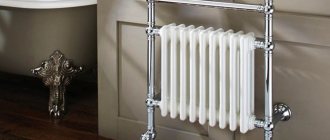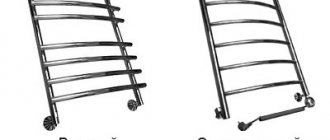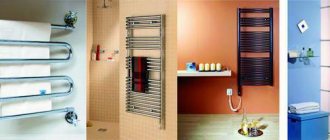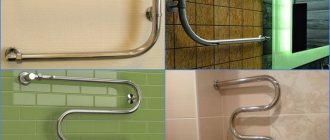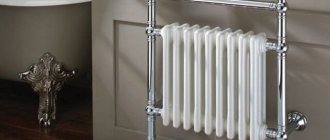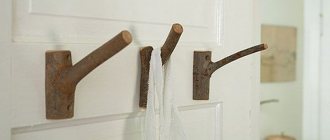Irina Beshlebnaya
Electric heated towel rails with low energy consumption have become popular among consumers in recent years. In this article we will look at the features of electric models, their differences from water dryers, and methods for installing and making such devices with your own hands.
The value of electric heated towel rails
One of the advantages is complete autonomy from central heating. This makes it possible to create the desired comfortable temperature in the bathroom, which is important if there is no general heating. An electric heated towel rail with a thermostat is easily regulated and automatically maintains the desired temperature in the room, instantly warming it up. This results in significant energy savings. When necessary, the heated towel rail can be turned off or switched to the lowest operating mode.
The thermostats of an electric heated towel rail perfectly perform the work of a heating heater; installation makes it easy to select its power. For a bathroom, the reality of full heating is an important point in ensuring the absence of moisture in a given room in the process of evaporating it and improving ventilation.
The design of an electric heated towel rail allows for convenient arrangement and drying of clothes and towels.
Its location adds comfort to the bathroom in maintaining personal hygiene and order. A heated towel rail with a thermostat basically has a timed switch on and off. It makes electrical costs optimal and increases safety when drying things.
Choosing an electric heated towel rail
The choice of heated towel rail by power is determined by considerations of the purposes for which it will be needed. A small power device can be purchased and it will be sufficient if it is needed only for drying towels and linen. If you want to use an electric heated towel rail as a heating device, you need to buy a high-power design, then its price will be much higher. A consultant can help you choose the right power; you just need to know the area of the room that will be heated by this device.
Today there are a large number of models of electric heated towel rails, which differ in:
- power;
- appearance;
- the presence of additional elements (timer, thermostat and others).
Floor-mounted and wall-mounted electric heated towel rails are also produced. The most popular is the device that has additional capabilities. You can purchase an electric heated towel rail with a thermostat in all stores that sell plumbing fixtures. It is very convenient to set the required temperature; it will dry towels slower or faster, and also warm up the bathroom to a comfortable state.
An electric heated towel rail with a timer will help you use the settings to turn the device on and off at the time the user needs and configure the assigned parameters. This is great for early risers and the winter season.
Floor-mounted and wall-mounted heated towel rails have quite significant differences. Floor-standing ones are more convenient, since it is possible to move them over the entire surface of the floor and place them in any position that is comfortable for a person. But if you are not sure that the floor is dry, it is better to opt for a mounted device.
Currently, you can find an electric heated towel rail with a shelf in stores. This model is equipped with a convenient device that allows you to save space in the bathroom due to the absence of additional surfaces in the form of a shelf. You can put dried towels and various detergents on it.
Power
The required power of the heated towel rail is determined by the purpose. If it is used to dry towels, other fabric products and to remove moisture and steam from the bathroom, then you can choose a model with minimal power.
In this situation, the choice of unit is made solely by size, color and design.
In cases where, according to the local conditions of the bathroom, the heated towel rail additionally takes on the functions of a heater, then according to SanPiN, the power is selected at the rate of 100 W per 1 m2 of area or 41 W per 1 m3.
When choosing a model, it is advisable to increase the calculated power value by 30 - 40%. In this case, the comfortable temperature is set using the regulator.
At the same time, the reserve relative to the calculated value does not lead to an increase in the cost of purchasing the unit.
Connecting an electric heated towel rail
When deciding to purchase an electric heated towel rail, you need to decide in advance on its location. It is recommended to place it next to an outlet, which should be well insulated and not exposed to moisture. Connecting a wall-mounted heated towel rail will require a drill; with its help you will need to screw in the fasteners, which will then hold the coil. The device will be ready for use when the user makes sure that the fastenings are secure and that the heated towel rail can be easily placed on them.
What is a heating element and how does it work?
The modern market of tubular electric heaters (TEHs) is represented by a wide selection of models from various manufacturers. Each model may have its own design features, but, in general, their design and operating principle are identical.
How does the heating element work?
As can be seen from the diagram, the heating element consists of:
- shell, presented in the form of a tube with thin walls;
- a spiral connected at the left end to the rod;
- a hermetically sealed tube, from the right of which a contact rod extends. From it, current is transferred to the spiral;
- insulating material that prevents short circuits to the tube body. It conducts heat well and does not allow current to pass through;
- sealing agents;
- porcelain sleeve;
- contact nut.
During the operation of the heating element, electrical energy is converted into thermal energy: due to the high heat transfer of the coil and the thermal conductivity of the insulator, the entire tube is heated, which in turn heats the water or oil inside the device.
And the design of an electric heated towel rail almost completely replicates the design of a heating element.
Design features of electric heated towel rails
The modern heated towel rail has a number of distinctive properties:
- The use of the latest technologies makes it absolutely safe, although it uses a high voltage of 220V for connection. The electric heated towel rail has excellent dielectric materials in its design; advanced technologies for isolating electric current were used in its manufacture. All this guarantees the absence of inducing currents on the housing and good heat transfer from the heater; the device has a high overall efficiency.
- The electric heated towel rail is highly reliable and has a long service life. Due to the fact that the design of the thermostat uses high-quality heating materials with an electrical automation and control circuit that is simplified in terms of repair. Therefore, this device can be used all year round.
- Installation of an electric towel rail eliminates the use of special tools: a soldering iron, welding machine, grinder; you can get by with an electric drill, mounting dowels of the “quick installation” variety. The fastening procedure will take a short amount of time; it can be carried out by anyone who is familiar with the operation of the drill.
- The device of any heated towel rail does not require the construction of special communications and can be connected to a regular outlet. Due to its complete independence, installation of an electric heated towel rail is possible anywhere. Many of its designs have special fastenings that help maintain the relative mobility of the device.
- Heated towel rails (thermostats) are available in a wide range, so you just need to choose a device based on design, power and construction. This electrical device does not require much space, fits perfectly into various bathroom interiors, and can be connected in a convenient place.
- The heating of the case has a maximum temperature of approximately 70°C. This is quite enough to fully heat the room and quickly dry the towels even in the cold season. In this case, the possibility of serious burns when touching it is completely eliminated. An electric heated towel rail has a minimum operating temperature of approximately 30°C. The towels will be in such a comfortable heated state without strongly heating the entire room.
By design, electric heated towel rails are divided into 2 types:
- Cable. Their scheme does not provide for the use of filler. The heating element is a special heated cable, so the location and connection of the heated towel rail can be anywhere. This type of heated towel rail almost instantly enters working condition, but since it does not have a thermal capacity, it cools quickly.
- Oily. The design of these heated towel rails assumes that the coolant in them will be an oil filler, which transfers heat from the heating element throughout the device and has a relative dependence on its location in space. This heated towel rail does not have any air in its heating element that could cause a blockage. Its design assumes the circulation movement of the oil filler; therefore, it is not recommended to install the heated towel rail at an angle deviating from the position indicated in the instructions. Electric oil heated towel rails have smooth, gentle heating and cooling.
Regardless of the design of the electric heated towel rail, installation and price will be different. They are:
- sexual;
- ceiling;
- wall
To connect and increase the electrical safety of oil-filled heaters, additional grounding is used.
Installation of an electric heated towel rail
Not everyone has the opportunity to install a water heated towel rail in their bathroom, so purchasing an electric device would be an excellent solution. It has some advantages:
- simple installation;
- ability to change the heated temperature;
- independence from hot water supply.
It is quite easy to install the “ladder” electric heated towel rail model yourself. There is absolutely no need to carry out welding work by wedging into the hot water supply system. When installing, you just need to mount the device in any convenient place on the wall and connect the heated towel rail to the electrical network.
The heated towel rail connection diagram provides for the presence of excellent electrical wiring in the house. This device is equipped with a heating element, which has quite high power and creates an additional large load on the network. There are generally no sockets in bathrooms, because 220 V voltage and high humidity are unacceptable. To connect a heated towel rail, you can drill a hole through the wall and run the power cable into another room.
There is another option. Install a socket protected from moisture by connecting it to the lamp. The outlet should be sealed into the wall, preferably not adjacent to rooms that are not heated to avoid the formation of condensation.
Electrically, the heated towel rail has the second class of protection and is equipped with a thermostat on a heating element. This allows you to set the desired heating temperature yourself; the connection diagram provides for automatic shutdown when overheating.
Connecting a heated towel rail
The connection of the heated towel rail occurs with the obligatory de-energization of the wires. Then you need to mark the places where the brackets are attached and make holes. The wall and brackets must be separated with seals. Then the connection diagram provides for stripping 5-10 mm of insulation from the connecting wires and connecting the heating element to the electrical network. The connection points are hidden in a connection box, which is required. If there is a socket in the bathroom, the heated towel rail is connected directly through the plug.
When you turn it on for the first time, this electrical device must be checked for accuracy of fastening and connection. It can be used around the clock. The required temperature is maintained automatically. It is not allowed to use an electric heated towel rail in a disassembled state or in rooms with damaged, unreliable electrical wiring. The product has detailed instructions, which include a diagram and describe the operating features and technical characteristics.
An electric heated towel rail does not have to be installed in the bathroom. This device can be installed in the hallway, kitchen and other places where there is a need to dry things. For more information on choosing an electric heated towel rail, click here.
Installation Rules
Unlike water heated towel rails, electric counterparts are not connected to water mains. They can be installed in any suitable place. You only need an outlet with the required power. The latter means that the cross-sectional area of the copper wires is chosen to be at least 2.5 mm2.
For installation at the workplace, fixed or rotating brackets are used. The design of the latter allows it to be tilted at an angle of up to 90°.
When located less than 0.6 m from a bathtub or shower stall, splash protection is provided for safety reasons.
The connection socket is equipped with a grounding contact, which is connected by a separate wire to the grounding bus in the panel. Due to the specific conditions of the operating area, sockets with waterproof housings are used.
In practice, there are two options for supplying power to the heated towel rail.
In the first case, hidden wiring is used for this , which improves the aesthetic parameters of the bathroom.
The second option is based on the use of a socket , which requires less installation costs, and turning off the device during operation becomes easier.
It is advisable to provide an emergency shutdown device as part of the power supply circuits.
In situations where there is an avid lover of hot baths in the house, it is advisable to move the outlet outside the bathroom. The connection cord is led out through a hole in the wall.




